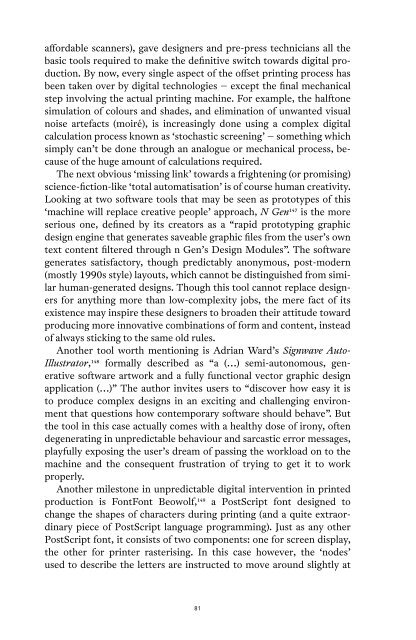Post- Digital Print - Monoskop
Post- Digital Print - Monoskop
Post- Digital Print - Monoskop
Create successful ePaper yourself
Turn your PDF publications into a flip-book with our unique Google optimized e-Paper software.
affordable scanners), gave designers and pre-press technicians all the<br />
basic tools required to make the definitive switch towards digital production.<br />
By now, every single aspect of the offset printing process has<br />
been taken over by digital technologies – except the final mechanical<br />
step involving the actual printing machine. For example, the halftone<br />
simulation of colours and shades, and elimination of unwanted visual<br />
noise artefacts (moiré), is increasingly done using a complex digital<br />
calculation process known as ‘stochastic screening’ – something which<br />
simply can’t be done through an analogue or mechanical process, because<br />
of the huge amount of calculations required.<br />
The next obvious ‘missing link’ towards a frightening (or promising)<br />
science-fiction-like ‘total automatisation’ is of course human creativity.<br />
Looking at two software tools that may be seen as prototypes of this<br />
‘machine will replace creative people’ approach, N Gen 147 is the more<br />
serious one, defined by its creators as a “rapid prototyping graphic<br />
design engine that generates saveable graphic files from the user’s own<br />
text content filtered through n Gen’s Design Modules”. The software<br />
generates satisfactory, though predictably anonymous, post-modern<br />
(mostly 1990s style) layouts, which cannot be distinguished from similar<br />
human-generated designs. Though this tool cannot replace designers<br />
for anything more than low-complexity jobs, the mere fact of its<br />
existence may inspire these designers to broaden their attitude toward<br />
producing more innovative combinations of form and content, instead<br />
of always sticking to the same old rules.<br />
Another tool worth mentioning is Adrian Ward’s Signwave Auto-<br />
Illustrator, 148 formally described as “a (…) semi-autonomous, generative<br />
software artwork and a fully functional vector graphic design<br />
application (…)” The author invites users to “discover how easy it is<br />
to produce complex designs in an exciting and challenging environment<br />
that questions how contemporary software should behave”. But<br />
the tool in this case actually comes with a healthy dose of irony, often<br />
degenerating in unpredictable behaviour and sarcastic error messages,<br />
playfully exposing the user’s dream of passing the workload on to the<br />
machine and the consequent frustration of trying to get it to work<br />
properly.<br />
Another milestone in unpredictable digital intervention in printed<br />
production is FontFont Beowolf, 149 a <strong>Post</strong>Script font designed to<br />
change the shapes of characters during printing (and a quite extraordinary<br />
piece of <strong>Post</strong>Script language programming). Just as any other<br />
<strong>Post</strong>Script font, it consists of two components: one for screen display,<br />
the other for printer rasterising. In this case however, the ‘nodes’<br />
used to describe the letters are instructed to move around slightly at<br />
81

















